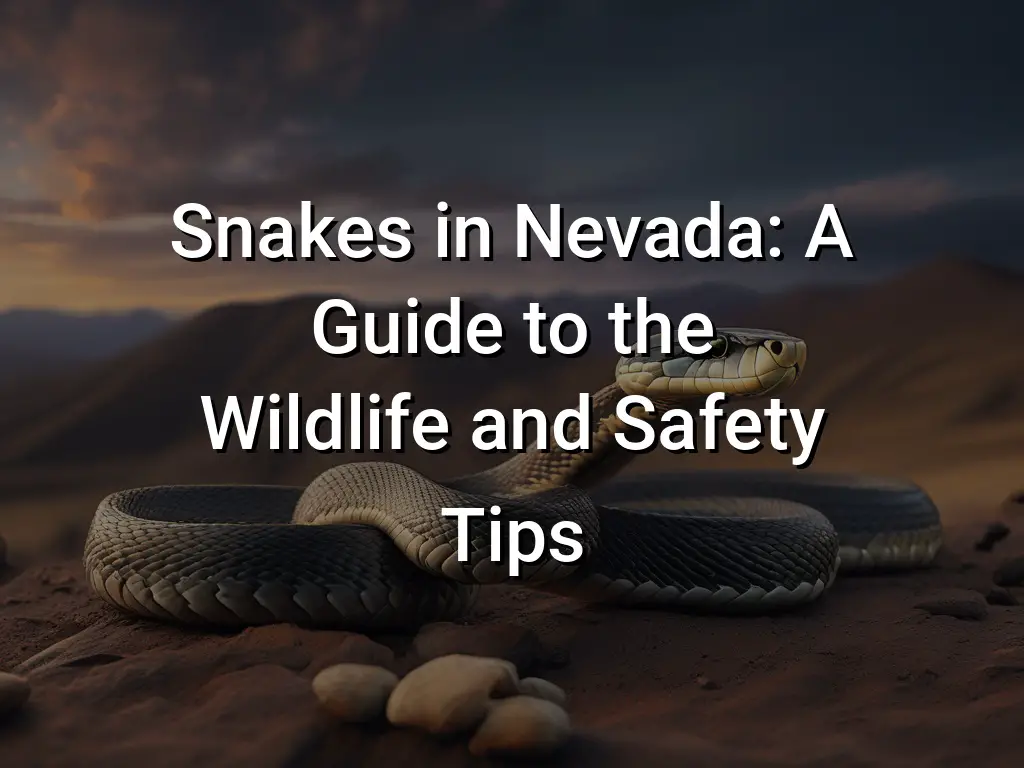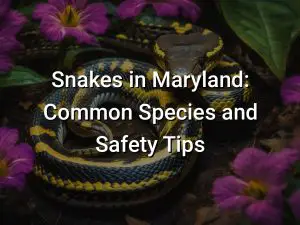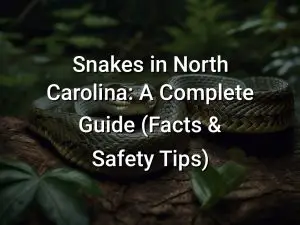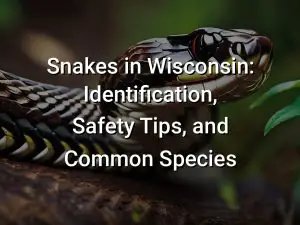Snakes in Nevada: A Guide to the Wildlife and Safety Tips

Nevada, known for its stunning desert landscapes and vast natural beauty, is also home to a variety of snake species that add to the richness of its wildlife. Whether you’re a nature enthusiast or just curious, this guide will provide you with valuable information on the different types of snakes found in Nevada, their habitats, and essential safety tips to keep in mind.
From venomous snakes like the Mojave Rattlesnake to non-venomous species like the California Kingsnake, the diverse snake population in Nevada offers a fascinating glimpse into the state’s ecosystem. We’ll also explore important topics such as snake bite safety, snake identification tips, conservation efforts, and how to deal with snake sightings or encounters. So, whether you’re planning a visit to Nevada or simply want to learn more about its wildlife, join us on this exciting journey into the captivating world of snakes.
Quick Links
Types of Snakes in Nevada
Nevada is home to a diverse range of snake species, each with its own unique characteristics. Here are some of the common types of snakes you may encounter in Nevada:
- Western Diamondback Rattlesnake: This venomous snake is known for its diamond-shaped markings and rattle on its tail. It is one of the most common and dangerous snakes in Nevada.
- Mojave Rattlesnake: Another venomous snake found in Nevada, the Mojave Rattlesnake has a distinctive greenish-gray color and a neurotoxic venom.
- Gopher Snake: This non-venomous snake resembles a rattlesnake but lacks the distinct rattle. It is often mistaken for a dangerous snake due to its defensive behavior.
- Great Basin Gopher Snake: Similar to the gopher snake, the Great Basin Gopher Snake is non-venomous and has a yellowish-brown color with dark blotches.
- Coachwhip Snake: This non-venomous snake is known for its impressive speed and agility. It has a long, slender body and a reddish-brown color.
- Bullsnake: Another non-venomous snake, the Bullsnake is one of the largest snakes in Nevada. It has a light brown color with dark blotches and is often mistaken for a rattlesnake.
These are just a few examples of the snake species found in Nevada. It’s important to remember that snakes play a vital role in the ecosystem and should be respected and observed from a safe distance.
Habitat of Snakes in Nevada
Nevada is home to a diverse range of snake species due to its varied landscapes. Snakes can be found in various habitats throughout the state, including deserts, mountains, grasslands, and wetlands.
Desert-dwelling snakes, such as the Mojave rattlesnake and the coachwhip snake, are well-adapted to the arid conditions and can be found in rocky areas, sand dunes, and desert scrub. These snakes are experts at blending into their surroundings and are often difficult to spot.
In the mountainous regions of Nevada, you may come across snakes such as the gopher snake and the western rattlesnake. These snakes prefer cooler temperatures and can be found in forested areas, rocky slopes, and grassy meadows.
Wetlands and marshes provide habitat for water-loving snakes, such as the western aquatic garter snake and the common garter snake. These snakes can be found near bodies of water, such as lakes, rivers, and streams.
It’s important to remember that snakes are ectothermic, meaning they rely on external sources of heat to maintain their body temperature. As a result, you may encounter snakes sunning themselves on rocks or other warm surfaces.
When venturing into snake habitats, it’s advisable to wear appropriate clothing, such as long pants and closed-toe shoes, to reduce the risk of a snake bite. Additionally, be cautious and watch your step, especially in areas with tall grass or thick vegetation where snakes may be hiding.
Venomous Snakes in Nevada
Nevada is home to several species of venomous snakes. It is important to be aware of these snakes and take necessary precautions while exploring the outdoors.
One of the most common venomous snakes in Nevada is the rattlesnake. There are several species of rattlesnakes found in the state, including the western diamondback rattlesnake, the Mojave rattlesnake, and the Great Basin rattlesnake. These snakes have venomous fangs and rattle their tails as a warning to potential threats.
Another venomous snake found in Nevada is the sidewinder. This snake is named for its unique method of moving across loose sand by looping its body sideways. The sidewinder has venomous fangs and is capable of delivering a harmful bite.
The coral snake is another venomous snake found in Nevada. It is easily recognized by its bright colors and banded pattern. Although coral snakes are generally shy and not aggressive, they possess potent venom and should be avoided.
If you encounter a venomous snake while hiking or exploring in Nevada, it is important to give it a wide berth and avoid any interaction. Do not attempt to handle or provoke the snake in any way.
If you are bitten by a venomous snake, seek immediate medical attention. It is crucial to stay calm and immobilize the affected limb to prevent the venom from spreading quickly.
Remember, prevention is key when it comes to dealing with venomous snakes. Always stay on designated trails, wear sturdy footwear, and be mindful of your surroundings while enjoying Nevada’s beautiful wildlife.
Non-venomous Snakes in Nevada
Nevada is home to a variety of non-venomous snakes that are harmless and play an important role in the ecosystem. It’s important to be able to identify these snakes to avoid unnecessary fear or harm. Here are some common non-venomous snakes you may encounter in Nevada:
- Gopher Snake: Gopher snakes are large and robust snakes that are often mistaken for rattlesnakes due to their similar appearance. However, gopher snakes are non-venomous and are actually beneficial to have around as they help control rodent populations.
- Bullsnake: Bullsnakes are another snake species that resemble rattlesnakes but are non-venomous. They have a distinct pattern and can grow quite large. Bullsnakes are known for their hissing behavior when threatened, but they are not dangerous.
- Rubber Boa: Rubber boas are small and stout snakes that have a unique appearance, with smooth and shiny scales. They are docile and rarely bite. Rubber boas are known to burrow in sandy soil, making them difficult to spot.
- Racers: Racers are fast-moving snakes that are known for their speed and agility. They are non-venomous and primarily feed on small rodents and reptiles. Racers are typically found in open areas and can be difficult to catch due to their quick movements.
- Garter Snakes: Garter snakes are one of the most common snake species in Nevada. They are relatively small and have a distinctive striped pattern. Garter snakes are harmless and are often found near bodies of water, as they are excellent swimmers.
It’s important to remember that even non-venomous snakes can bite if they feel threatened or cornered. If you encounter a snake in the wild, it’s best to give it space and observe from a safe distance. Snakes play a vital role in the ecosystem and should be respected and protected.
Snake Bite Safety Tips
Encountering a snake in Nevada can be a nerve-wracking experience. While most snakes in Nevada are harmless, it’s important to know how to stay safe in case of a snake bite. Here are some essential snake bite safety tips to keep in mind:
- Stay Calm: If you encounter a snake, try to remain calm and avoid panicking. Snakes are more likely to bite if they feel threatened, so it’s important to keep your distance and give them space.
- Back Away Slowly: If you find yourself near a snake, slowly back away and create a safe distance between you and the snake. Avoid sudden movements or trying to handle the snake, as this can increase the risk of being bitten.
- Wear Protective Clothing: When venturing into areas where snakes may be present, it’s a good idea to wear long pants, boots, and thick socks to minimize the risk of a snake bite.
- Watch Where You Step: Pay attention to where you’re walking, especially in tall grass, rocky areas, or near water sources. Snakes are masters of camouflage and can be difficult to spot. Stick to well-traveled paths and avoid reaching into or under brush piles.
- Never Approach or Handle Snakes: Even if a snake appears to be non-venomous, it’s important to remember that any snake can still bite. Avoid touching or attempting to handle snakes, as this can lead to bites and potential injuries.
- Know First Aid for Snake Bites: Familiarize yourself with basic first aid techniques for snake bites. If bitten, keep the affected area immobilized and lower it below heart level if possible. Seek medical attention immediately.
- Stay Informed: Educate yourself about the types of snakes found in Nevada and learn how to identify venomous species. Being able to recognize venomous snakes can help you take appropriate precautions and seek immediate medical attention if necessary.
Remember, while encounters with snakes can be alarming, most snakes are harmless and play an important role in the ecosystem. By following these snake bite safety tips, you can coexist with these fascinating creatures while minimizing the risk of a bite.
Snake Identification Tips
Being able to identify snakes is essential for ensuring your safety in Nevada. Here are some tips to help you identify snakes:
- Color and pattern: Look for distinctive colors and patterns on the snake’s body. This can help you determine if it is venomous or non-venomous. Venomous snakes often have bright colors or patterns that serve as a warning.
- Head shape: Pay attention to the shape of the snake’s head. Venomous snakes typically have triangular-shaped heads, while non-venomous snakes have more rounded heads.
- Pupils: Check the shape of the snake’s pupils. Venomous snakes usually have vertical pupils, like a cat, while non-venomous snakes have round pupils.
- Body shape: Consider the overall shape of the snake’s body. Venomous snakes tend to have thicker bodies compared to non-venomous snakes.
- Tail: Examine the snake’s tail. Venomous snakes often have a rattle at the end of their tails, while non-venomous snakes do not.
Remember, it is always best to observe snakes from a safe distance and avoid approaching or disturbing them. If you are unsure about the identification of a snake, it is recommended to contact local wildlife authorities for assistance.
Snake Conservation Efforts in Nevada
Nevada is home to a diverse range of snake species, some of which are threatened or endangered. As a result, there are ongoing efforts to conserve and protect these snakes and their habitats.
One of the primary organizations involved in snake conservation in Nevada is the Nevada Department of Wildlife. They work to monitor snake populations, study their habitats, and implement conservation strategies to ensure their long-term survival.
Conservation efforts include habitat restoration and preservation. This includes protecting and maintaining areas of native vegetation and providing snake-friendly habitats, such as rocky outcrops and brushy areas.
Another important aspect of snake conservation is educating the public about the importance of snakes in the ecosystem and how to coexist with them safely. The Nevada Department of Wildlife and other organizations offer educational programs and resources to help increase awareness and promote snake conservation.
In addition to these efforts, there are also research projects focused on understanding the ecology and behavior of snakes in Nevada. This information helps inform conservation strategies and better protect the snakes and their habitats.
Overall, snake conservation efforts in Nevada are essential for maintaining the biodiversity and ecological balance of the region. By protecting these reptiles and their habitats, we can ensure their survival for future generations.
Snake Repellents and Deterrents
When it comes to dealing with snakes in Nevada, there are several repellents and deterrents that can help keep them away from your property. While these methods may not guarantee a completely snake-free environment, they can be effective in reducing the likelihood of snake encounters. Here are some options to consider:
1. Natural repellents: Certain strong-smelling substances, such as cinnamon oil, clove oil, and peppermint oil, are known to repel snakes. Spraying these oils around your property, especially in areas where snakes are likely to hide, can help deter them from entering your space.
2. Chemical repellents: There are also commercial snake repellents available that contain chemical substances that are unpleasant to snakes. These repellents typically come in granular or spray form and are applied to the perimeter of your property. It’s important to follow the instructions carefully when using these products.
3. Snake-proof fencing: Installing snake-proof fencing around your property can be an effective way to keep snakes out. This type of fencing is designed to prevent snakes from slithering through gaps or climbing over barriers. The fence should be buried a few inches underground and angled away from your property to prevent snakes from burrowing underneath.
4. Habitat modification: To make your property less attractive to snakes, you can take steps to eliminate potential hiding spots. Keep your lawn well-maintained, remove clutter, and trim shrubs and tall grasses. By reducing clutter and creating an open space, you are less likely to attract snakes to your property.
5. Professional snake deterrent services: If you need help in dealing with snakes, consider hiring a professional snake deterrent service. These professionals are experienced in handling snakes and can provide guidance on effective deterrent methods specific to your property. They may use techniques like trapping and relocation to keep snakes away.
Remember, while these methods can help reduce the likelihood of snake encounters, it’s important to always exercise caution and be aware of your surroundings. If you do come across a snake, it’s best to keep your distance and contact local authorities or wildlife experts for assistance.
Nevada Snake Sightings and Encounters
Nevada is home to a diverse range of snake species, and encounters with snakes can occur in various outdoor environments such as deserts, mountains, and even urban areas. If you come across a snake while exploring Nevada’s wildlife, it’s important to know how to safely handle the situation.
First and foremost, it’s crucial to remember that most snakes in Nevada are non-venomous and not a threat to humans. However, it’s always best to exercise caution and treat all snakes as potentially dangerous until you can identify them.
If you encounter a snake, the best course of action is to back away slowly and give it space. Snakes generally prefer to avoid human contact and will usually retreat if given the opportunity. Do not attempt to handle or approach the snake, as this can provoke defensive behavior.
It’s also important to educate yourself about the venomous snakes that inhabit Nevada, such as the Mojave rattlesnake and the Great Basin rattlesnake. These snakes can deliver a venomous bite, and it’s crucial to seek medical attention immediately if bitten by a venomous snake. Remember to stay calm and try to keep the affected limb immobilized while you wait for help.
Preventing snake encounters can be achieved by following a few simple guidelines. When hiking or exploring outdoor areas, stick to well-worn paths and watch where you step. Avoid tall grass, rocks, and other potential hiding spots for snakes. Wearing closed-toe shoes, long pants, and using a hiking stick can provide added protection.
If you reside in an area with a high snake population, taking precautions around your home can also reduce the chances of snake encounters. Keep your yard well-maintained and free of debris, as snakes are attracted to places where they can hide. Seal off any openings or gaps in your home’s foundation or walls to prevent snakes from entering.
By being aware of your surroundings, understanding snake behavior, and taking necessary precautions, you can safely navigate snake sightings and encounters in Nevada’s wildlife.
Snake Removal and Control in Nevada
Encountering a snake in your home or property can be a cause for concern. While snakes play an important role in the ecosystem, it is understandable that you may want to remove them for safety reasons. Here are some tips for snake removal and control in Nevada:
- Prevention: The best way to keep snakes away is to prevent them from entering your property in the first place. Seal any cracks or gaps in your home’s foundation, repair broken screens, and eliminate any potential hiding spots such as piles of debris.
- Remove Attractants: Snakes are attracted to areas with a lot of food sources. Keep your property clean and free of rodents, as they are a common food source for snakes. Secure garbage cans and bird feeders to avoid attracting unwanted pests.
- Professional Help: If you have a snake infestation or are uncomfortable handling snakes on your own, it is best to seek professional assistance. Contact a licensed pest control company or a wildlife removal specialist who can safely and humanely remove snakes from your property.
- Safe Snake Removal: If you choose to remove a snake yourself, it is important to do so safely. Always wear protective clothing, including long sleeves, long pants, and closed-toe shoes. Use a snake hook or a long-handled tool to gently guide the snake into a container with a secured lid. Release the snake in a suitable outdoor location away from residential areas.
- Snake Fencing: If you live in an area prone to snake encounters, you may consider installing snake-proof fencing around your property. Snake fencing is typically made of fine mesh material that prevents snakes from slithering through.
Remember, snakes are important for controlling rodent populations and maintaining the balance of the ecosystem. If you encounter a snake outdoors, it is best to leave it alone and give it space to retreat. Educate yourself and your family about snake species in your area to better understand their behavior and reduce the risk of snake bites.
Conclusion
Living in Nevada means sharing the landscape with a variety of snake species, both venomous and non-venomous. It’s important to be aware of the types of snakes you may encounter, their habitats, and the safety precautions you should take to avoid snake bites.
By following the safety tips outlined in this guide and being cautious when exploring snake territory, you can coexist with these fascinating creatures and appreciate their role in the ecosystem. Remember, if you ever come across a snake and are unsure of its venomous nature, it’s best to err on the side of caution and give the snake plenty of space to retreat.







